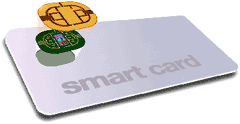Contact Smart CardsContact smart cards have an embedded integrated circuit chip that contains just memory, or memory plus a microprocessor. Memory-only chips are functionally similar to a small floppy disk. They are less expensive than microprocessor chips, but they also offer less security and should therefore not be used to store sensitive or valuable information. Chips that contain both memory and a microprocessor are also similar to a small floppy disk, except they contain an "intelligent" controller used to securely add, delete, change, and update information contained in memory. Sophisticated microprocessor chips have state-of-the-art security features built in to protect the contents of memory from unauthorized access. Contact smart cards must be inserted into a reader to read and store information in the chip. This type of e-card is used in a wide variety of applications including network security, vending, meal plans, loyalty, electronic cash, government IDs, campus IDs, e-commerce, health cards, and more.
|
Contactless Smart CardsContactless smart cards are similar to contact smart cards, except contactless cards do not have to be inserted into a card acceptor device. Instead, contactless smart cards contain an embedded antenna for reading and writing information contained in the chip's memory. They need only be passed within range of a radio frequency acceptor to read and store information in the chip. The range of operation is typically from about 2.5" to 3.9" (63.5 mm to 99.06 mm) depending on the acceptor. Contactless smart cards are used in many of the same applications as contact smart cards, especially where the added convenience and speed of not having to insert the card into a reader is desirable. There is a growing acceptance of this type of card for both physical and logical access control applications. Student identification, electronic passport, vending, parking, and tolls are common applications for contactless cards.
|
Proximity CardsProximity cards (aka, prox cards, access cards) communicate through an antenna similar to contactless smart cards except that they are read-only devices that generally have a greater range of operation. The range of operation for prox cards is typically from 2.5" to 20" (63.5 mm to 508 mm) depending on the reader. Small amounts of information can be read with prox cards, such as an identification code that is usually verified by a remote computer; however, it is not possible to write information back to the card. Prox cards are available from several sources in both ISO thickness cards from 0.027" to 0.033" (0.6858 mm to 0.8382 mm) and "clamshell" cards from 0.060" to over 0.070" thick (1.524 mm to over 1.778 mm). Prox cards continue to grow in popularity because of the convenience they offer in security, identification, and access control applications, especially door access where fast, hands-free operation is preferred.
|
Hybrid CardsHybrid cards offer a unique solution for updating your existing badging system. Hybrid card is the term given to cards that contain two or more embedded chip technologies, such as a contactless smart chip, a contact smart chip, and/or a proximity chip—all in a single card. The contactless chip is typically used for applications demanding fast transaction times, such as mass transit. The contact chip can be used in applications requiring higher levels of security. The individual electronic components are not connected to each other even though they share space in a single card.
|
Combi CardsThe combi card—also known as a dual-interface card—has one smart chip embedded in the card that can be accessed through either contact with a reader or an embedded antenna. This form of smart card is growing in popularity because it provides ease-of-use and high security in a single card product. Mass transit is one of the more popular applications for the combi card; a contact-type acceptor can be used to place a cash value in the chip's memory and the contactless interface can be used to deduct a fare from the card.
|
Data Storage on ID Cards
Critical visual identification information should be placed clearly on the badge. For security and privacy reasons, many organizations encode information to their cards to keep information confidential and secure. There are several types of cards available for data storage on ID cards. It’s best to consult an ID Professional to determine the best type of card for your application.





